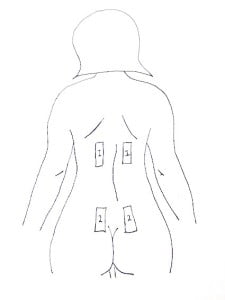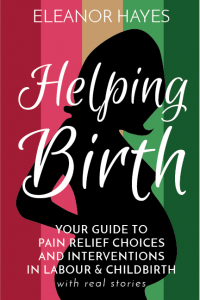Birthzang’s Guide to Using a TENS Machine in Labour
TENS Machine in Labour
Most women don’t like the idea of using pain relief in in
What is a TENS machine?
TENS stands for Transcutaneous Electrical Nerve Stimulation. It consists of a small battery-powered machine about the size of a mobile phone that produces a very small electrical current. You attach sticky pads to your skin and the electrical current is sent through your body from one set of pads to the other.
The electric current stimulates the nerves under the skin and it seems to work in two ways depending on the frequency of the current. A high current appears to confuse the nerve
TENS Machine Hire

Hire a TENS Machine to help you cope with labour & birth. Collection from Frome or posted options.
How do you use a TENS machine in
To use a tens machine in
You can reuse the gel pads a number of times (so you can take it off and put it back on again – ensure it is switched off first!) but it is advisable to have fresh pads if you have hired or borrowed the machine.
Each TENS Machine is slightly different but they all have the same basic function. From the first contractions, you allow a continuous low current. This helps to boost the body’s natural endorphins.
During a contraction, you increase the frequency and switch on the pain relief part of the TENS – stimulating the nerve signal s to the brain and stopping the pain signals from getting through.
When the contraction has finished, you switch back to the low-level current.
You can set the intensity of the current at both the low and the high levels so you can build it up as
TENS machines designed for
What does it feel like?
Using a TENS machine feels a bit like someone is holding a couple of electric toothbrushes against your skin! It has a kind of buzzing feeling, a very fast and soft vibration. Of course, you feel it under the skin but it is not an unpleasant sensation. The main area of sensation is the pads themselves.
What are the side effects of a TENS machine?
The amazing thing about a TENS Machine in
When can’t you use a TENS machine?
It is not advised to use a TENS machine if you have a pacemaker, a heart rhythm disorder (such as arrhythmia or epilepsy), so please seek medical advice
It is also not advisable to use a TENS machine on your abdomen during pregnancy, but it is fine to try it out on an arm or leg to figure out how it works before
You can’t use a TENS machine in water – it is an electrical device remember! – so if you have a shower or bath, or get into a birth pool you will need to remove it. Once you are finished though you can put it back on.
Some people find they are mildly allergic to the gel pads that stick to your back. The TENS has to have a moist connection to your skin so will only work if the gel is against your skin. You should also avoid putting the pads onto broken skin.
But does it actually work?
Well, the crazy thing is that the answer to this is both a resounding Yes and a resounding NO!!!
Birthzang did a (fairly unscientific) poll of mums on my Facebook network and out of 62 responses, discovered that
- 35% said it helped a bit
- 24% said it helped a lot
- 18% said it was completely brilliant
- 21% said it didn’t help at all
- 2% said it was a complete waste of money!
So clearly there is a lot of differences of opinion about whether it works, although overall 75% reported positive results. Looking at the comments mums made, however, did shed some light on the situations where TENS machines were better or worse and maybe add some guidelines to use.
- Correct positioning of the pads made a big difference to its efficacy.
- It helps most when used early on in
labour , so don’t leave it too late to use it (this is probably because you need time to build up the endorphin levels). - It was more of a distraction rather than pain relief.
- It really helped with
a posterior labour (when your baby is back-to-back). - It doesn’t help very much for
labours that come on fast andstrong, or are induced (again the endorphins can’t build up). - You need to start at a low level and build it up slowly, rather than using a high frequency early on which is just annoying.
Here are a few comments that I feel sum up the consensus.
Marina: “It did take the edge off from contractions but that was about it.“
Julie: “It’s only when I took it off did I
So what does science say?
This is where it gets very interesting though.
A 2009 Cochrane review of studies looking at using a TENS machine in
There is only limited evidence that TENS reduces pain in labour and it does not seem to have any impact (either positive or negative) on other outcomes for mothers or babies. The use of TENS at home in early labour has not been evaluated. TENS is widely available in hospital settings and women should have the choice of using it in labour.
So no real evidence that it has any great effect, but that it is good to have as an option.
A further review in 2011, reached the same conclusions and added:
Although the guidelines of the National Institute for Health and Clinical Excellence recommend that TENS should not be offered to women in labour, women appear to be choosing it and midwives are supporting them in their choice. Given the absence of adverse effects and the limited evidence base, it seems unreasonable to deny women that choice. More robust studies of effectiveness are needed.
So no-one is telling women to use it and yet they are choosing to do so anyway and more studies are needed.
Then I came across this damning article from a well-respected
What about the claim that TENS increases endorphin levels and therefore is useful in encouraging natural birth? I have not seen any research that shows TENS increasing endorphin levels in labour. There may be some evidence of increased endorphin levels when TENS is used in other situations (but I haven’t found that either), but it any case, it would be unwise to assume from any such studies, that a similar effect would occur in labour, given that birth is a completely different physiological condition.
Of course, just because there is no evidence does not always mean that is isn’t working, just perhaps the studies have not actually looked at this particular aspect and have instead focussed on the pretty subjective reporting of mums of their pain in
Just a placebo effect?
So then it looks as if using a TENS machine in
If it is just creating a distraction from the sensations of contractions, if it is just allowing a delay before using other pain relief options or interventions, if it is just giving you something to focus on during contractions, if it is just helping you feel in control of your
IF IT WORKS THEN WHO CARES????????
Make sure you get a product that is tested and approved by
TENS Machine Hire

Hire a TENS Machine to help you cope with labour & birth. Collection from Frome or posted options.
My recommendations
I personally liked the Elle TENS machine best as it was really easy to use and had quite an intuitive interface. It is good to get a TENS machine designed for
Here are the main
TENS Hire
I also hire TENS machines to people local to Frome or I am happy to arrange postage for an extra fee. You can book TENS hire via my booking system CLICK HERE but be sure to email me with your address if you want to have it posted. Cost is £20 for hire and £28 posted (that pays for postage both ways via My Hermes).
References
https://en.wikipedia.org/wiki/Transcutaneous_electrical_nerve_stimulation
https://patient.info/health/tens-machines-leaflet
https://www.which.co.uk/birth-choice/articles/coping-with-pain-in-labour?gclid=CjwKEAjwq6m3BRCP7IfMq6Oo9gESJACRc0bNFS0PBi2sL9kOEulVrRqYnpiSyJYmH4q-8a4pHefAmRoCw_bw_wcB
https://www.nhs.uk/conditions/tens/Pages/Introduction.aspx
https://www.ncbi.nlm.nih.gov/pubmed/19370680
https://www.birthinternational.com/articles/childbirth-education/136-tens-a-marketing-triumph


